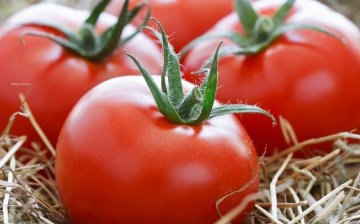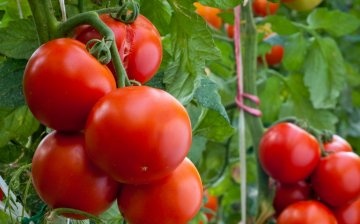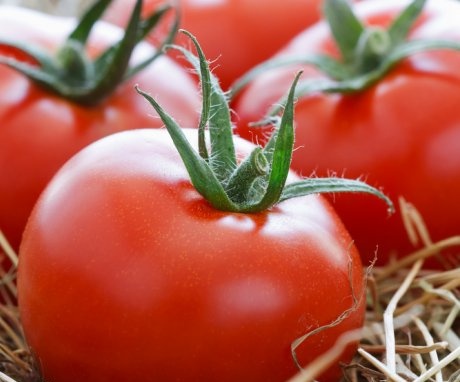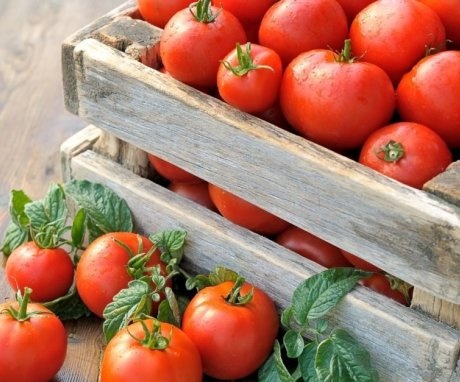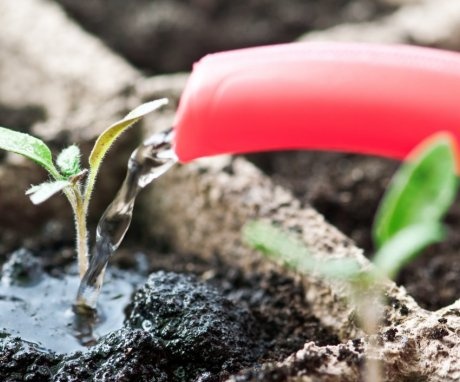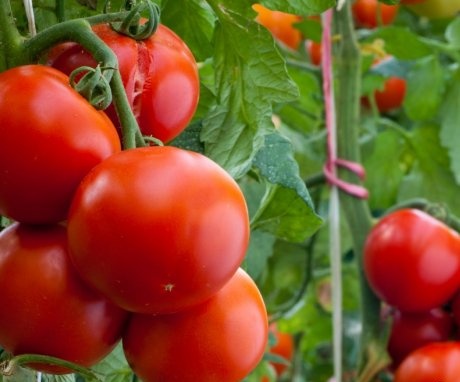What are the most productive varieties of tomatoes? Review of the best
Tomatoes enjoy the well-deserved attention of vegetable growers. The variety of varieties of this plant of the nightshade family is amazing. When deciding which varieties to choose, gardeners tend to get more tomatoes from the allotted area.
Content:
- Open field tomatoes
- Tomato varieties for greenhouses
- How to properly grow tomato seedlings
- Proper care is the key to a large harvest
Open field tomatoes
Almost all tomatoes can be grown in open soil. Low (determinant) can be grown even by novice vegetable growers. In plants of determinant varieties, fruits begin to form after 5 leaves, and they themselves do not grow above the last inflorescence. These are usually early varieties.
Most of those who grow tomatoes at home prefer varieties with medium-sized fruits. This will make it possible to prepare tomatoes for the winter, preserving them in jars. But who would refuse tomatoes that grow up to 300 or even 700 g each?
Low high-yielding tomatoes:
- Hybrid "Aurora-F1" refers to ultra-early. The plant is not tall, covered with red tomatoes weighing more than 100 g. From 1 sq. M. m you can get more than 14 kg. Not affected by Alternaria.
- Cultivation of the "Alpha" variety allows you to get the first fruits in 86 days. Tomatoes are red, not very large. But a large number of them allows you to collect 6.5 kg from 1 sq. m. It is not affected by late blight. Tomatoes are eaten fresh.
- Antoshka is an early tomato with small yellow tomatoes. Like all varieties of this color, it has a pleasant sweet taste. From 1 sq. m. they can be collected more than 5 kg. Productivity up to 5.5 kg per square meter. Early ripening variety (95 days). Can be susceptible to fungal diseases. The purpose is universal.
- The "Supermodel" variety is early maturing. Fruits are pink, plum-shaped. The weight of one is about 110 g. Productivity is 5.3 kg per 1 sq. m2.
- "Aquarelle" will delight you with red oblong oval-shaped tomatoes weighing 95 g. From each bush you can get about 4 kg of fruit.
- "Alsou" was created for the harsh West Siberian climate. Productivity up to 9 kg per 1 m2. Early, short. Heart-shaped tomatoes.
- "Gaiduk-F1" is an ultra-early variety. Red tomatoes, each weighing 140 g. Resistant to major diseases.
Nowadays, many high (indeterminate) varieties have been created. They make it possible to collect 2-4 times more fruits than from determinant varieties. But in order to grow them, the gardener needs to put in more effort. It is necessary to pinch the plants, tie the stems to the supports. But the tomato will thank you for the care and attention with a high yield. In addition to large-fruited, these tomatoes are distinguished by a longer fruiting period. This allows you to extend the period of consumption of fresh tomatoes for several months.
The most productive of them:
- "Barmaley" with pink, rounded, slightly flattened fruits weighing about 200 g. Productivity is about 15 kg per 1 sq. M. m. Fleshy fruits of salad destination ripens early.
- "Lemon giant" is a tomato whose name indicates the main characteristics. Medium ripening. The tomatoes are yellow, slightly flattened. The weight of one sometimes reaches 900 g. From 1 m2. you can get more than 14 kg.
- "Bogatyr Maslova" - The yield of the variety is 12 kg from 1 m2. Tomatoes are red, large, up to 0.4 kg, slightly flattened on top. They are eaten fresh.Not affected by pests.
- "Pink Flamingo" is a medium height bush with pink cream. Each weight is about 170 g. Ripening period is average. It is not affected by diseases of the nightshade.
- "Dubok" is an early maturing variety (from 85 days). The fruits are round, red. Weight up to 110 g. Productivity is about 7 kg per 1 m2.
Tomato varieties for greenhouses
Varieties that only bear fruit in the greenhouse:
- Gina
- Buddy
- Cavalier
Varieties for open ground are also grown. Usually in the greenhouse more fruits are tied and they grow larger. After all, it is easier to create plants suitable for tomatoes there:
- "Intuition F1" is a high variety with an average ripening period (100 days). The fruits are fleshy, red, the weight of one is about 110 g. The yield is from 26 to 32 kg per 1 m2.
- Anyuta F1 is an early hybrid. Fruits are large, flattened, 120 g each. Productivity is 12 kg per 1 m2.
- "Ural F1" is a tall bush with 350 g of tomatoes. Up to 8 kg are harvested from the bush. Not affected by cladospirosis and fusarium.
- "De Barao", an old and proven variety, in the open field yields up to 10 kg per 1 m2, and in a greenhouse yields up to 32 kg. Tomatoes are one-dimensional, beautiful, albeit small. Placed in a jar.
How to properly grow tomato seedlings
The soil in which the tomatoes will be sown is of great importance. They take humus and sod land, add peat or sawdust. They will make it crumbly. Tomatoes grow well and quickly in a coconut substrate. The acidity of the soil should be in the range of 5.5-6 pH. Before sowing seeds, the soil disinfect, spilling boiling water, a solution of potassium permanganate or calcined for 10 minutes in the oven at 200 ° C. But they don't sow right away. You need to let the soil settle for a couple of weeks so that a sufficient number of beneficial bacteria appear there.
Seeds are prepared. Soaking in juice aloe, diluted by half with water and kept for 5 days in the refrigerator. Then it is soaked for a day in a glass of water, in which 1 g of soda is dissolved. It will promote earlier fruiting.
For disinfection, the seeds are placed in a solution of Fitosporin or potassium permanganate.
Sow the seeds in a bowl with holes in the bottom. The seeding depth is 1 cm. The distance between the rows is 4 cm, between the seeds in a row is up to 3 cm. Cover the dishes with glass or foil. Place in a warm room (about 26 ° C). Late varieties are sown earlier than early ones. This is usually mid-March. Averages 14 days later. The early ones are sown later than everyone else, in mid-April.
Seedlings appear in a week. The temperature in the room is lowered to 18 ° C so that the plants do not stretch up. Dishes with seedlings are placed in a sunny place. The temperature is gradually increased, bringing it to 24 degrees. You need to water it with warm water, without getting on the leaves. With excessive moisture, plants can get sick and die. But you can't dry it out either, it can die. It is advisable to add complex mineral fertilizers.
Proper care is the key to a large harvest
Seedlings are planted when they have grown to 30 cm. For indeterminate varieties, the planting pattern is 70x90 or 100x100. This will allow the plants to grow and develop freely. With this planting scheme, plants will be much less affected. diseases... The stem of a plant in regions with short summers is usually left alone. The longer the summer, the more fruits will have time to ripen. Therefore, in the south, you can leave several stems.
Features and rules of care:
- To get a high yield, plants need to be fed periodically. You can use the infusion chicken droppingsfermented and diluted 1:10.
- Growing in a greenhouse differs from open ground in that in a greenhouse, plants need to be watered, pollinated, and regularly ventilated.
- Water the tomatoes every 5 days so that the soil is not too wet. Before they bloom, up to four liters of warm water with a temperature of about 23 degrees is applied per 1 m2. During the period when the fruits begin to grow, and in the future, this rate is increased by 3 times.
- In the greenhouse, it is necessary to provide for the presence of vents. It needs to be ventilated by adjusting not only the temperature, but also the air humidity.If it is too high, tomatoes will be poorly pollinated, which will not allow for a high yield.
- Tomatoes are pollinated on a sunny day, shaking flowering inflorescences. Then the vents are opened to ventilate the room, and the flowers are sprayed with warm water. The temperature in the greenhouse should not exceed 27 degrees.
More information can be found in the video:




